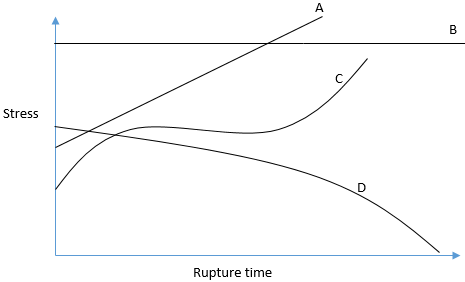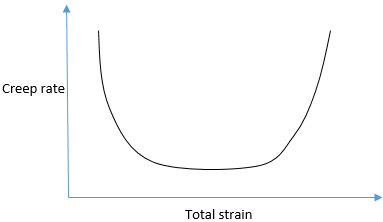This set of Mechanical Metallurgy Multiple Choice Questions & Answers (MCQs) focuses on “Stress-Rupture Test – 1”.
1. Typically the creep rate is measured in which unit?
a) Length/minutes
b) Load/length
c) Percentage change of length/hour
d) Percentage change of length/percentage change of time
View Answer
Explanation: The creep rate is measured in term of percentage per hour. In some cases, the creep rate is prolonged, so it is determined in terms of percentage per days or even months.
2. The creep test and the stress-rupture test are the same things representing the same type of curve at equal stresses.
a) True
b) False
View Answer
Explanation: The stress rupture test is different from the creep test. The objective of the creep test is to determine the creep rate of the material, so usually, low stress is applied and strain is limited to 0.5. While in the stress-rupture trial, the material is tested till the breaking point and the applied load and stresses are also very high.
3. Which curve in the following graph is correctly showing the relationship between the stress and rupture time of the material?

a) A
b) B
c) C
d) D
View Answer
Explanation: As the stress increases on the material, they tend to experience much higher forces on their bonds, and the rupture time will decrease. The curve D represents the reduction in the required stress with increasing time or vice versa.
4. The change in the slope of stress-rupture line is not due to _____________
a) metallurgical change
b) necking of the material
c) oxidation
d) recrystallization
View Answer
Explanation: The change in the slope of log-log stress rupture curve in an indication of sudden change in the value of required stress to cause the rupture of the material. So, it is always associated with metallurgical, internal phenomena of the material. The necking is physical change, so not included in the list.
5. The following graph represents the relation between the creep rate and the total strain:

a) True
b) False
View Answer
Explanation: The creep rate is defined at the change in length/strain with time. So in the primary state, the creep is high but decreasing then in the secondary state it becomes constant, and finally, it increases again till fracture.
6. The large-grained aluminum is most suitable for creep related study.
a) True
b) False
View Answer
Explanation: The aluminum forms a thin protective oxide layer on its surface, so it eliminates the possibility of oxidation of sample at high temperature.
7. In aluminium the creep occurs by slip on the _______ planes.
a) {110}
b) {100}, {111}
c) {200}
d) {311}
View Answer
Explanation: The aluminium is FCC material, so at room temperature, slip occurs at {110} plane. But at higher temperature, other planes becomes operative such as {100}, {111} or {211} .
8. The slip band produced at higher temperature are _______ and ________ spaced than for a room temperature deformation.
a) fine, widely
b) fine, narrow
c) coarse, widely
d) coarse, narrow
View Answer
Explanation: At higher temperatures, the slip bands produced are coarser and much more widely spaced compared to bands form at room temperature.
9. The formation of sub-grain structure inside the lattice is a phenomena observed in the high-temperature creep. The number of new sub-grain formed are highest in which stage of creep?
a) Primary
b) Secondary
c) Tertiary
d) Equal in all phase
View Answer
Explanation: Most of the subgrain formation takes place in the primary stage only. With increasing time, the material enters the secondary stage and subgrain only grow, by keeping the number of subgrains almost constant.
10. The slip bands inside a grain during creep was first observed by which instrument?
a) Scanning electron microscope
b) Transmission electron microscope
c) Phase-contrast microscopy
d) X-ray diffraction
View Answer
Explanation: The first-ever live observation of slip band in creep was made by Mclean using phase-contrast microscopy and able to detect very fine slip band lines.
Sanfoundry Global Education & Learning Series – Mechanical Metallurgy.
To practice all areas of Mechanical Metallurgy, here is complete set of 1000+ Multiple Choice Questions and Answers.
If you find a mistake in question / option / answer, kindly take a screenshot and email to [email protected]
- Practice Metallurgical Engineering MCQs
- Apply for Metallurgical Engineering Internship
- Check Metallurgical Engineering Books
- Check Mechanical Metallurgy Books
